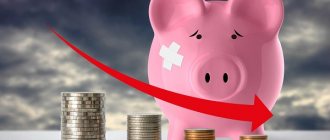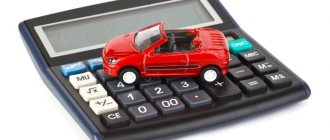How to calculate return on investment? - This question interests every investor. The main goal of investing is to generate income, so it’s always interesting how much you earned and what your profitability is. In terms of profitability, mutual funds, stocks, bonds, deposits, real estate and many other instruments are compared. Any investor, trader or manager is interested in its effectiveness. Banks, management companies and brokers, when advertising their services, like to lure clients with high interest rates. Profitability is one of the most important indicators by which you can evaluate the effectiveness of investments and compare them with other investment alternatives. So, let's figure out what return on investment is and how to calculate it.
Return (rate of return, rate of return) is the degree to which the invested amount increases (or decreases) over a certain period of time. Unlike income, which is expressed in nominal values, that is, in rubles, dollars or euros, profitability is expressed as a percentage. Income can be received in two types:
- interest income is interest on deposits, coupons on bonds, dividends on shares, rent on real estate;
- increase in the value of purchased assets - when the sale price of an asset is greater than the purchase price - these are stocks, bonds, real estate, gold, silver, oil and other commodity assets.
Assets such as real estate, stocks and bonds can combine two sources of income. Calculation of profitability is needed to assess the growth or decline of investments and is a criterion for assessing the effectiveness of investments.
How to calculate return on investment?
In general terms, return is always calculated as profit (or loss) divided by the amount invested multiplied by 100%. Profit is calculated as the amount of the sale of the asset - the amount of the purchase of the asset + the amount of cash payments received during the period of ownership of the asset, that is, interest income.
Formula 1
An example of calculating return on investment.
We bought a share at a price of 100 rubles (investment amount), sold a share at a price of 120 rubles (sale amount), and during the period of holding the share we received 5 rubles in dividends (cash payments). We calculate the profitability: (120-100+5)/100 = 0.25 ∗ 100% = 25%.
Formula 2
There is a second formula, according to which the profitability is calculated as the amount of sale of the asset + the amount of cash payments divided by the amount of investments, minus 1, multiplied by 100%.
Example of profitability calculation: (120+5)/100 - 1 ∗ 100% = 25%.
Formula and subtleties of margin calculation
Based on the definition of margin, it is calculated using a simple formula:
Pmarj. = Vr – Rper.
Where:
- Pmarj. – marginal profit;
- Вр – the amount of revenue from sold goods, services, works;
- Rper. – variable expenses.
When calculating marginal profit, it is important to remember some accounting features:
- Revenue for this formula is taken excluding VAT and excise taxes.
- Variable expenses are those expenses that are directly related to the volume of products produced and the quantity sold.
- If during some accounting period the products were not sold or produced, this means that at that time the organization did not incur variable costs.
- Variable costs do not react in any way to changes in pricing policy, expansion of assortment, technological modernization and other factors. The decisive factors are solely the volume of production and/or sales.
Calculating margin - an indicator of marginal income - is convenient for comparison with other financial categories, data for various types of products, or figures that other enterprises show. The margin is calculated as follows:
M = Pmargin. / Time x 100
Where:
- M – margin;
- Pmarj. – marginal profit;
- Вр – the amount of revenue from sold goods, services, works.
This indicator highlights the percentage share of marginal profit in sales revenue.
How to calculate profitability as a percentage per annum?
The formula for calculating simple profitability does not take into account such an important parameter as time. 25% can be obtained in a month, or in 5 years. How then can one correctly compare the returns of assets whose holding periods differ? To do this, calculate the yield as a percentage per annum . Yield as a percentage per annum is calculated in order to compare the performance of assets with different holding periods. Yield as a percentage per annum is profitability reduced to a single denominator - profitability for the year.
For example, a bank deposit gives 11% per year, and some shares brought 15% for 1.5 years of ownership, which was more profitable? At first glance, the shares, after all, brought more profitability. But the investor owned them for more than six months, so their profitability seemed to be extended over time compared to the deposit. Therefore, in order to correctly compare the deposit and shares, the return on shares must be recalculated as a percentage per annum.
To do this, add the coefficient 365/T to the formula, where T is the number of days of holding the asset.
An example of calculating profitability: We bought a share for 100 rubles, sold it after 1.5 years for 115 rubles. 1.5 years is 1.5*365=547 days.
(115-100)/100 ∗ 365/547 ∗ 100% = 10%. In this case, the deposit turned out to be slightly more profitable than the shares.
Like forex, management companies, brokers and banks manipulate annual returns.
In any advertisement of profitability, pay attention to the footnotes, clarify what profitability is indicated in the advertisement and for what period. For example, the advertisement says the yield is 48% per annum. But it can be received in just one month. That is, the company earned 4% in a month and now proudly advertises a product that gives 4*12=48% per annum. Even you, having earned 1% per day on the stock exchange, can boast that you earned 365% per annum) Only this profitability is virtual.
Management accounting in an organization.
Many Russian managers do not have a clear understanding of management accounting at the enterprise. As a rule, many people imagine management accounting as a type of accounting and mistakenly believe that having a department such as accounting at an enterprise is enough to control and promptly manage the company.
In this article, the author will try, as they say, “on the fingers” to explain what management accounting is, how to correctly calculate profits and how to manage expenses.
What is management accounting.
Unlike accounting and tax accounting, which are strictly regulated by standards and legislation, management accounting is conducted in accordance with the information needs of the management of a particular organization. Therefore, there are many different approaches to the development of a management accounting system, to the methods of its maintenance, and even to the very definition of management accounting.
As a rule, management accounting is developed for a specific company, with its individual needs. And even each manager may have his own calculation of net profit.
How to calculate profit.
For example, let's look at how to calculate profit at a manufacturing enterprise, because this is a more complex calculation than, for example, for trade and services. For a better understanding, here is a block diagram of the movement of enterprise assets.
This flowchart does not indicate possible movements of assets between suppliers and banks, suppliers and partners, buyers and banks, buyers and partners.
Profit can usually be calculated in two ways. The first and easiest is to calculate assets at the beginning and end of the reporting period (the period for which you want to find out your profit). On the “fingers” this can be explained as follows. At the beginning of the month you had 100 rubles in your pocket, and at the end of the month you had 1000 rubles, which means that during the month you earned 900 rubles. To calculate profits using this method, it is necessary to determine the areas where these assets are stored. Regarding our block diagram, we can highlight the following assets:
- MATERIAL VALUES
- STOCK
- CASH REGISTER
- BANK
- PARTNERS
- MONEY ON THE WAY
- LOANS
- ACCOUNTABLES
- BUYERS' DEBT
- DEBT TO SUPPLIERS
1. Material assets are the only asset that is not visible on the asset movement block diagram. Now let’s try to figure out what material values are in our understanding.
Material assets are goods that are not involved in the process of making a profit, i.e. They are not bought in order to sell them later and make a profit. Each business will have its own. For example, a refrigerator for a household appliances store will be a product (if the refrigerator is for sale), but for a store that sells office supplies, it will be a material value. Such assets also include equipment, office equipment, etc. Some of these assets are called “fixed assets” in accounting.
This asset is considered as the difference between the cost of this asset (purchase price) and its write-off. There are no problems with calculating the receipt of such assets - you bought something and fixed its value. But there are disagreements regarding the write-off of these assets. Each manager wants to write them off in his own way, one wants to write off less materials as expenses in order to receive (see) more profit, others want to write off everything at once so that, in their opinion, they see a more pessimistic picture. I would like to immediately point out that in the long term, both such managers will get the same result! As a result, all these assets will be written off anyway.
Let's consider 3 types of calculation of this asset:
- The accounting method is based on the gradual write-off of a given asset, the so-called depreciation. In this case, the service life of the purchased object is determined, and over time this object is gradually written off.
- The second method is based on the immediate write-off of this asset. As soon as this object is received by the organization, it is immediately written off.
- The third write-off method (which the author adheres to) is based on the gradual write-off of a given asset as payment for the given object occurs.
In fact, there is no point in gradually writing off such assets if they are eventually written off anyway. But the second method is bad for another reason.
Let's say you bought a car on lease. You have already received it and are working on it. According to the second calculation method, you must write it off. But you have not yet paid money for it, or you have paid partially. And it turns out that you write off as expenses money that you have not yet earned!
Therefore, there is a third write-off method, which, in the author’s opinion, is the most optimal. You bought a car, put it on your balance sheet, and write it off as you pay for it. Once the car is paid for, it can be written off as an expense.
Let us separately consider the situation regarding fixed assets. Indeed, sometimes it is interesting to look at the cost of fixed assets.
Let's say you are developing a company and your profit is always very small due to the fact that you are constantly spending money on the development of the company, for example, purchasing new cars to deliver goods to your customers. In the main financial statement, you expense this asset as you spend money on these vehicles. But these cars still cost money and it’s interesting to see how much they cost. In this case, no formulas or laws are suitable for calculating these assets. Only the market is involved here. Let's say you bought a good Japanese car and worked on it for 15 years. During this period, you have already paid for this car a long time ago and it has served its term. Both according to accounting and management estimates, its price is zero rubles, but in fact, you can sell it without much difficulty, for example, for 100 thousand rubles.
Approximately the same picture can be viewed in the opposite direction. Let’s say you bought a new car yesterday, but didn’t calculate your financial capabilities and decided to sell it. It will be a great success if you sell it for the price at which you bought it. As a rule, your new car will lose 10-20% of its value.
Therefore, it is more correct to count these assets separately and not mix it with the main financial statement! You can create a separate table with assets that you consider fixed assets. Someone can even include computers in them that can be sold in 10 years for 1000 rubles! In this table, you can set market prices as needed and see the value of your material assets.
3. Warehouse – these are goods that are intended for sale and are the main source of profit. The more expensive it is to sell a product, the greater the profit will be.
Here you also need to pay attention to the price at which these goods are inventoried. Some people believe that remaining goods should be calculated at the selling price. It is not right! After all, in business, purchasing goods is only half the battle. One of the important stages of business is to sell a product profitably. Therefore, the presence of a product in a warehouse does not mean that you will sell it, and therefore the balance of goods must be calculated at the purchase price (cost).
This cost should not be confused with the accounting cost, which includes various expenses such as salaries, taxes, utility costs, etc.
It is very important to pay attention to the write-off of goods. Here everyone can decide for themselves at what price to write off the goods. For example, if you gave a product to someone from a warehouse, then it is logical to write it off at cost. But if the goods are lost or damaged from the warehouse and need to be thrown away, then you can write off the goods at the selling price, because this is a lost profit.
4. Cash desk is the money that is in the cash register.
5. Bank is the money that is in the company’s bank account.
Here it is necessary to talk about one more asset that may appear as a result of the work of the bank and cash desk. This asset can be called “MONEY IN WAY”, it arises due to time costs. For example, on January 31st, funds are collected from the cash desk to the bank. But this money will appear in the bank only on February 1st. Thus, if you count assets at the end of the month (on January 31), it turns out that this money is not in the cash register, but it is not in the bank either. But in fact they exist.
In this case, it is necessary to fix one more asset “MONEY ON THE WAY”. And when collection occurs on the last day of the month, the money will be recorded in this account. On the 1st of the next month, money will be withdrawn from this account and sent to the bank.
6. Partners are your money that is in the cash desk or bank account of another company - a partner company. For example, your client is very far from you and he wants to pay for your services in cash, but it is not practical for him to come to you and hand over the money to the cashier. But you have a partner company, which is geographically located close to your client. In this case, the client can give money to your partner. And if necessary, the partner will transfer this money to you.
7. Loans are money that you lent to someone (for example, employees), or, on the contrary, borrowed from someone.
8. Accountables are money that you gave to your employees to purchase any goods or pay for services. The difference between loans and imprest money is that imprest money is a potential expense (usually it will be spent), while loans come back to you in the form of cash.
9. Customer debt is money owed to you by your customers (often called accounts receivable). This asset is highly liquid, because it's actually your money. This liquidity is disrupted only by the client’s inability to return this money. For example, a client has gone bankrupt and all his assets are not enough to pay off the debt. In this case, this money will have to be written off.
This asset requires constant monitoring, because Clients, as a rule, are in no hurry to pay. Therefore, it is important to correctly draw up an agreement with the client, defining the payment system - the deferred payment period, the amount of the fine for late payment.
10. Supplier debts are money you owe to suppliers (often called accounts payable). For a good balance of cash, it is necessary to ensure that accounts receivable do not exceed accounts payable.
We have described all the assets that need to be considered when calculating profit. Below is an example of this report.
As you can see, the first method of calculating profit is quite simple. To determine profit, it is enough to calculate assets at the beginning and end of the reporting period.
The disadvantage of this report is that it does not show the quality of the profits made. There are no visible mechanisms by which this profit can be increased. Therefore, a second type of report is needed, which shows profit relative to the movement of goods and cash.
Below is an example of such a report.
To understand this report, let’s show at a glance the principle of generating this report. Let's say you had 100 rubles. You spent it on buying an old computer. You printed an abstract on it and sold the abstract for 1000 rubles. To do this essay, for 1000 rubles, you spent 100 rubles, which means you earned 900 rubles.
In this report, unlike the previous one, you see how you earned money. Here you can conclude that if you increase the number of essays sold, you will increase your profit.
Now let's look at the report in detail. As we found out, one of the most important indicators that forms profit is the total expression of goods and services sold. Or more precisely, the markup on these products. For example, you bought a refrigerator for 10,000 rubles, you sold it for 11,000 rubles, which means the markup is 1,000 rubles. If you subtract financial and material costs from this amount, you get profit. In the above report, these indicators are highlighted in red.
“Items shipped” is the sum of all goods sold and written off. It consists of the amounts: “Goods sold” and “Write-off”. Goods sold is the amount of goods sold for which you will receive money.
“Purchased goods sold” is the amount spent on the purchase of goods that have been shipped. It consists of the amount of “Purchased goods” (this is all purchases for a given period) and “Purchased but not sold” (this is the total difference in goods at the beginning and end of the reporting period, this amount can be seen in the report calculating profit on assets).
“Financial expenses” are money spent on any purpose: salaries, utility costs, taxes, etc.
“Depreciation” is the amount of write-off of material assets.
“Write-off” is the shipment of goods without payment. For example, gifts, shortages, marriage, etc.
“Sales return” is an indicator showing the percentage of markup on purchased goods.
“Total profitability” is the profitability of the entire business. Unlike return on sales, it takes into account all financial expenses. If the overall profitability is positive, then the business is profitable.
How to manage expenses.
To manage expenses, it is necessary to introduce concepts such as budgeting and planning.
As a rule, it is practically impossible to plan all expenses in a large organization; at some point, unforeseen expenses will inevitably appear. Therefore, some expenses have to be cut. In order to quickly and correctly reschedule expenses, it is necessary to introduce budgeting.
Any enterprise can be divided into divisions that have responsible persons and that need finance to solve their problems. For example, the HR department can provide information on how much money is needed for salaries and vacation pay. Accounting will be able to provide information on how much money is needed for taxes. This way, each department can provide information about its expenses. Based on this information, a budget is drawn up.
Each responsible person should be given access to information that shows the operating expenses of their department. This is necessary for managers to exercise self-control.
When issuing money from a cash register or bank, control is also required. If the department's budget is exhausted, then such an operation must be blocked. In this case, the head of the company must analyze current expenses, and if the required payment is very important, then cut expenses in other departments where expenses are not of great importance.
This approach to regulating expenses allows you to get a stable profit.
How to calculate average annual return
The tenure of assets can be several years. However, most assets do not grow by the same amount. Assets such as stocks can fall or rise by tens or hundreds of percent per year. Therefore, I would like to know how much your investments grew on average per year. How then to calculate the average annual return? The average annual return is calculated by taking the root using the formula:
Formula 1
where n is the number of years of ownership of the asset.
An example of calculating profitability if we owned the stock for 3 years: 3√125/100 - 1 ∗ 100% = 7.72%
Formula 2
Another formula for calculating average annual profitability is through exponentiation.
The profitability using this formula is very easy to calculate in Ecxel. To do this, select the POWER function, in the Number line enter the quotient of division 125/100, in the Power line enter 1/n, where instead of n enter the number of years, add -1 outside the brackets.
In the cell, the formula will look like this : =POWER(125/100,1/3)-1 . To convert a number to a percentage, select the Percentage cell format.
Marginal profit: what is it?
The profit of an enterprise is formed as a result of the production of products and its sale, minus the costs incurred in the process of this production, as well as the costs of organization and management.
Marginal profit (from the English “Margin” or the French “Marge”, which means “difference”) is the income of an enterprise generated by the proceeds from the sale of a certain volume of goods minus the costs generated in the production process (variable costs) of the same volume of products.
This financial category is sometimes called the “coverage amount”, since it is at its expense that the costs of labor remuneration for personnel are covered, and the remainder is the businessman’s net profit.
Marginal analysis is important in justifying management decisions in business. His methodology is based on the relationship between the three most important economic indicators (costs, sales volume, profit) and forecasting the value of each of these indicators at a given value of the others. How is the profitability of marginal profit assessed in the system of marginal analysis of an economic entity? View answer
A close, but not identical term is gross income . The difference with marginal profit is that non-production costs are also taken into account, and it is also calculated per unit of production. Marginal profit takes into account the entire range of manufactured goods, thereby characterizing the overall profitability of the enterprise.
The word “margin” is sometimes used in professional slang to refer to the marginal profit itself, but more often it refers to the marginal profitability indicator (it is calculated as a percentage).
FOR YOUR INFORMATION! An increase in marginal profit means an increase in the enterprise's net profit due to faster reimbursement of variable production costs. It is the increase in marginal profit that is the goal of various management strategies used to increase the profitability of production.
marginal income calculated and ?
Ways to influence the growth of marginal profit
- An intensive way to increase marginal profit is to take into account the marginality category within one industry.
- An extensive way to influence margin growth is to increase the price of the product, as a result of which the marginal percentage of revenue will increase. Sometimes, in order to maintain or even increase sales volume, companies may offer additional services or other bonuses along with the product.
Low-margin goods receive a limited trading margin when sold. But you can influence the ratio of marketing low- and high-margin products by paying more attention to advertising the latter, providing them with additional discounts, bonuses and other ways to increase sales.
For example, in pharmaceuticals, dietary supplements and cosmetics are more marginal than commonly used medicines. Pharmaceutical companies do not have the right to raise the markup above the level established by the state. But they can advertise dietary supplements more, stimulate employees who ensure a high level of sales, negotiate with doctors who will recommend them to their patients, and use other marketing techniques. This way you can influence the ratio of sales of high- and low-margin groups of goods.
ATTENTION! In business practice, it makes sense to wisely combine both of these methods of increasing marginal profit.
Calculation of interest on deposits with capitalization
For example, with a deposit amount of 100,000 rubles and an interest rate of 4% for 3 months with monthly capitalization. Thus, the bank will accrue interest on a monthly basis, which will be added to the deposit amount to calculate the interest in the next period.
Conditions for deposits
from banks of Nizhny Novgorod
Look
• 1 month: 100,000 * 4% / 12 = 333.3 rub. This amount will be added to the deposit amount for calculation in the next period - the second month.
• 2nd month: (100,000 + 333.3) * 4% / 12 = 334.44
• 3 month: (100,000 + 333.3 + 334.44) * 4% / 12 = 335.56.
Total profitability for 3 months: 1003.3 rubles.
Without capitalization, the profitability would be 999.99 rubles, the difference over 3 months is 0.103%.
At first glance, the difference is small, but with a higher deposit amount and a longer-term investment of funds in a bank deposit, the difference in income will be more noticeable.
Portfolio return and net asset growth
The profitability and growth of net assets directly depends on how high-quality instruments are selected by the investor. Collecting a portfolio is a labor-intensive task that requires deep analytics to achieve good results.
The assets in the portfolio can be of any type - from stocks to cryptocurrencies. The main goal of the investor is to obtain maximum profit with minimum risks.
One of these methods is diversification, that is, splitting a large asset into the purchase of various smaller ones. Thus, even if a small part of the purchased shares falls, you will still be able to gain a stable profit at the expense of other financial instruments. Why is diversification in widespread demand? It's simple.
The investor maintains a stable profit dynamics and also freely regulates those assets that have become less profitable. Thanks to this action, you can easily sell less liquid shares and then buy the most interesting solutions.
This process will require detailed study, but at a distance it will play a key role. No experienced investor will risk money by investing it in just one asset. You need to regularly purchase shares of other companies to expand your investment portfolio. This is the only way to achieve stable profitability by regularly adjusting the shares in your portfolio, replacing them with more profitable offers.
Limitations of Contribution Margin Analysis
The method of analysis and forecast, which is based on the marginal profit indicator, cannot be 100% effective. It is subject to some restrictions due to the economic meaning of the concept of margin. So, when analyzing the profitability and profitability of an enterprise using margin calculations, you need to take into account the following nuances:
- Even with constant production costs, the market price of a product can change sharply for various reasons, and even an increase in output volume will not affect the real indicator, unlike the calculated one.
- Fixed and variable costs may change places from time to time, which will distort the calculated margin figure.
- Other variable factors are not taken into account, in addition to the volume of output, which can also affect sales, and therefore marginal profit: such as technological characteristics, changes in wages, personnel productivity, etc.
- The margin calculation method assumes that all manufactured products were sold, and this is not always the case.
Principle of taxation
Individuals are required to pay Who and in what cases must pay income tax? Income tax (NDFL). More often, personal income tax is paid not by the citizen himself, but by the official employer, who automatically withholds a set percentage from the salary. The citizen receives a “net” salary, from which personal income tax has already been deducted and paid.
Legal entities are taxed according to a different principle - depending on the chosen form of taxation.
Property income is also taxed separately. The fee is fixed and amounts to 13%. It is paid upon the purchase and sale of real estate.
So that the tax authorities know about the amount of incoming funds, declarations are provided. They are filled out annually at the end of the reporting period and submitted to the regulatory authorities (local tax inspectorate offices).
The information should include:
- Accounts and the amount of funds in them that are opened in banks outside the Russian Federation.
- A citizen has securities, bonds, shares and other issuers that are issued by other states.
- Available real estate outside the territory of the Russian Federation.
How to interpret the contribution margin ratio
Marginal profit is needed to determine the company's break-even strategy. You can do it for each type of product from the assortment and for the entire production.
Break -even is a state of production (output volume) in which the amount of revenue and costs (variables plus constants) balance each other. This volume can be calculated as follows:
Vwithout. = Рconst / (C unit – Рper.)
Where:
- Vwithout. – volume of goods ensuring break-even production;
- Рconst – fixed expenses (total amount);
- Tsed. – selling price of a unit of manufactured products;
- Rper. – the cost of 1 unit of goods sold (variable costs per unit of production).
In other words, the break-even volume depends on what proportion of the “coverage amount,” that is, the marginal profit, will cover the fixed costs of each unit of production.
In addition to break-even analysis, the margin indicator is used for:
- developing a management strategy for making decisions regarding the assortment;
- forecasting the activities of both your company and competitors;
- planning pricing policy.







